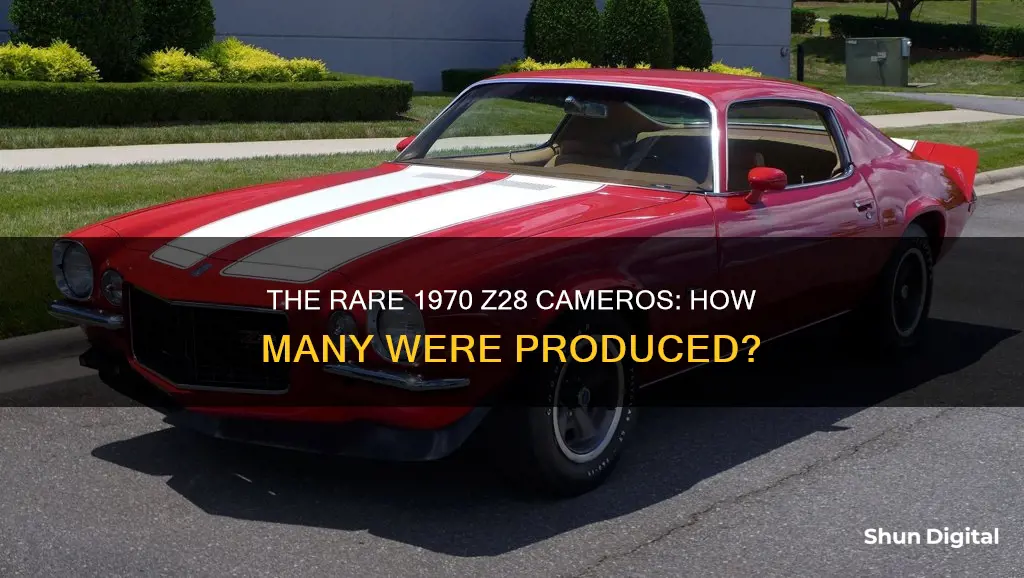
The Chevrolet Camaro has been around for over 55 years, and one of its most iconic trim levels is the Z28. The 1970 Chevrolet Camaro Z28 is particularly notable as it was one of the last great Camaros produced before stricter emissions regulations came into force. This model was introduced on February 26, 1970, as part of the second generation of Camaros, which lasted until 1981. The 1970 Camaro Z28 was not a separate model line but an add-on option that transformed the car from a daily driver to a muscle car. This generation of the Camaro was longer, lower, and wider than its predecessor, with improved aerodynamics thanks to its fastback roofline and curved angles. Under the hood, it was equipped with the famous 350 cubic inch engine, producing 360 horsepower, and for the first time, buyers could choose between a four-speed manual or three-speed automatic transmission.
What You'll Learn

The 1970 Chevrolet Camaro Z28 was a special trim package
The Z28 was introduced in December 1966 and continued into the second generation of Camaro in 1970. The 1970 model was a significant one for the Camaro, with a new design and an amazing look. The second-generation Camaro was lower to the ground, longer, and wider than the previous generation. The new body style was more aerodynamic, with a fastback roofline and more curved angles. The side windows were now one solid piece, without vents, and the doors were longer, making access to the rear seats easier. The 1970 Camaro Z28 had an aggressive look to match its performance upgrades.
The Z28 was equipped with the 350 cubic inch LT-1 engine, which produced around 360 horsepower and 380 foot-pounds of torque. This was a significant upgrade in performance, and for the first time, the Z28 could be ordered with a three-speed turbo automatic transmission as well as the traditional four-speed manual.
The 1970 model also introduced a rear stabilizer bar, giving the Camaro a more controllable driving experience and reducing its reputation as a wild ride. The steering and suspension were also improved, with a new steering gear that reduced over-steering and a unique linkage design that created a more pronounced toe-in, resulting in more manageable handling.
While the 1970 Camaro Z28 was an impressive performance car, some felt it was not as exciting to drive as earlier versions. The improvements to handling and stability meant that the thrill of being on the edge of control was diminished. However, the 1970 Z28 was one of the last great classic muscle cars, with the muscle car era coming to an end due to stricter emissions regulations, rising insurance premiums, and high gas prices.
Charging Your Fuji X-S1: A Quick Guide
You may want to see also

The second-generation Camaro had a new design and look
The second-generation Chevrolet Camaro debuted in 1970 and was produced through the 1981 model year. It was an all-new car with a new design and look, featuring much more rounded styling. The second-generation Camaro was longer, lower, and wider than its predecessor. It featured a unibody structure, a front subframe, an A-arm and coil spring front suspension, and rear leaf springs. The new body style had a fastback roofline and ventless full-door glass with no rear side quarter windows. The doors were wider, improving access to the rear seat, and the roof was a new double-shell unit for better rollover protection and noise reduction. The base model had a separate bumper and grille design, while the Rally Sport option included a distinctive grille surrounded by a flexible Endura material, round parking lights, and bumperettes. The rear featured four round taillights similar to the Corvette.
The second-generation Camaro was available in a two-door coupe body style only, and a convertible was no longer offered. In addition to the base model, buyers could choose from the 'RS' appearance package, the 'SS' performance package, and the 'Z28' Special Performance Package. The interior of the second-generation Camaro featured a new curved instrument panel with several round dials and switches in front of the driver. The optional center console was now integrated into the lower dashboard.
The second-generation Camaro was initially well-received, with the 1971 SS350 being included in the 10 best cars in the world by Road & Track in August 1971. However, sales declined due to various factors, including a corporate-wide strike at GM, rising insurance rates, and the energy crisis. Despite these challenges, the Camaro remained popular, and sales increased in the late 1970s, with the 1978 Camaro topping all previous years with 272,631 units sold.
Charging Your 4K Dual Action Camera: A Quick Guide
You may want to see also

The Z28 came with the upgraded LT-1 engine
The 1970 Chevrolet Camaro Z28 was a high-performance sports car that came with the upgraded LT-1 engine, a 350-cid V8 powerplant. This engine was also used in the Corvette, and it gave the Z28 a significant performance boost over the previous generation Camaro and its competitors. The LT-1 engine produced 360 horsepower and 380 lb-ft of torque, which was a substantial increase over the previous generation's 302-cid engine. This extra power, combined with improved suspension and handling, made the 1970 Camaro Z28 a true muscle car and a world-class road car.
The LT-1 engine in the 1970 Camaro Z28 had several key features that contributed to its performance. Firstly, it had solid lifters, which helped to reduce valvetrain mass and allowed for higher engine speeds. Secondly, it had a "hot cam" and big valves, which improved airflow and allowed the engine to breathe better. Thirdly, it had aluminum pistons, which reduced weight and improved the engine's power-to-weight ratio. Finally, it had a high compression ratio of 11.0:1, which increased the engine's thermal efficiency and power output.
The LT-1 engine in the 1970 Camaro Z28 was also notable for its use of a 780-cfm Holley four-barrel carburettor. This large carburettor provided a significant amount of fuel to the engine, which helped to produce the high horsepower and torque figures. The four-barrel design also improved the engine's responsiveness and drivability, making the Z28 a more well-rounded car for both performance driving and everyday use.
In addition to the upgraded LT-1 engine, the 1970 Camaro Z28 also benefited from a number of other performance-enhancing features. These included a $206 Hurst-shifted Muncie four-speed transmission, Positraction 3.73:1 gears, and Polyglas F60xl5 tyres. The Z28 also had improved suspension and handling compared to the previous generation Camaro, with firmer underpinnings that provided a more stable and controlled ride.
The 1970 Camaro Z28 was also visually distinctive, with hood and decklid striping, a black grille, and seven-inch-wide mag-type steel wheels with polished lugs. It also came with a standard rear spoiler, although the air-induction hood found on the previous generation was dropped. The Z28 could be combined with the Rally Sport package, which included a unique nose treatment with a soft Endura grille surround and chrome bumperettes.
Mastering Manual Focus with Fuji Cameras
You may want to see also

The Z28 had two transmission options
The 1970 Chevrolet Camaro Z28 was a significant model in the history of the Camaro, and it offered buyers a choice of two transmission options.
The first option was a manual transmission, and there were three types available: the M20, M21, and M22. The M20 and M21 were manufactured by Muncie, while the M22 was a heavy-duty variant of the M21 with a higher nickel content in its gears. The M22 was also known as the "Rockcrusher" due to the distinctive whining noise it produced when in use. The M20 was available with any of the high-performance engines offered in the Camaro, except for the L78 and Z28 in 1967, which came with the M21. The M20 was the only 4-speed transmission offered with the SS350 and SS396/325 hp (L35) engines. The M21 was available exclusively with the SS396/350 hp (L34) engine and the solid-lifter engines (Z28, L78, and COPO). The M22 was initially limited to just the solid-lifter engines but was later offered with other high-performance engines starting in 1970.
The second transmission option was an automatic transmission, specifically the Turbo Hydramatic 400 3-speed automatic. This was the first time an automatic transmission had been offered in the Z28, and it was made possible by the increased low-end torque of the new LT-1 engine. The Turbo Hydramatic 400 was a significant upgrade over the previous Powerglide 2-speed automatic, which had been available in the first-generation Camaro. The new transmission offered improved performance and a smoother driving experience.
The availability of these two transmission options gave buyers a choice between the sporty feel of a manual transmission and the convenience and ease of an automatic. The manual transmission, particularly the M22, was favoured by those seeking a more performance-oriented driving experience, while the automatic transmission broadened the appeal of the Camaro to those who preferred a more relaxed driving style.
In addition to the transmission options, the 1970 Camaro Z28 also offered other notable features and improvements. The car had undergone a wholesale change in design, with a new coupe body that became an instant classic. The engine had been upgraded to the Corvette's 350-cid LT1 V-8, producing 360 bhp. The suspension had been refined for better handling and road-holding, and the interior had been improved with new Strato bucket seats and a curved instrument panel. The 1970 Camaro Z28 was praised by Car and Driver as "an automobile of uncommon merit... a car of brilliant performance."
Wireless Cameras: Battery-Powered Security?
You may want to see also

The Z28 had a new steering and suspension system
The 1970 Chevrolet Camaro Z28 was a significant evolution of the muscle car, with its new steering and suspension system playing a pivotal role in its performance and handling capabilities. This iteration of the Camaro Z28 boasted a more mature and refined driving experience, marking a transition from the carefree adolescent spirit of its predecessors.
The steering system is a critical aspect of any vehicle's safe and functional operation, and the 1970 Camaro Z28 offered two forms: Manual Steering as the standard option and variable ratio Power Steering (RPO N40) as an optional upgrade. Power steering was included with the Type LT trim. The power steering system featured a hydraulic pressure-assisted recirculating ball nut mechanism, enhancing driver control and reducing the effort required to turn the wheel.
The suspension system of the 1970 Camaro Z28 underwent significant advancements. All Camaros from this year benefited from suspension refinements that improved both performance and comfort. The Z28, in particular, had firmer underpinnings, including sticky Polyglas F60xl5 tyres, contributing to its exceptional road handling capabilities. The suspension setup provided a more compliant ride, absorbing road imperfections and reducing noise and vibration. This compliance also had the effect of toeing the wheels in an understeering direction, which made the car's handling more manageable during transient manoeuvres.
The steering and suspension systems worked in harmony to deliver a car that was praised for its road handling. The 1970 Camaro Z28 offered predictable and stable handling during transitions, such as entering a curve or changing direction. This was achieved through the combination of the steering linkage position and the suspension compliance. Additionally, the low body roll angle further enhanced the car's road-holding abilities.
However, the Z28's exceptional transient handling came at a compromise. The engineers had to balance ultimate cornering ability with transient behaviour, and they prioritised the latter. As a result, the car tended to understeer heavily when pushed to its limits on a race track or an empty road. The lack of road feel and driver confidence at the limit was a shortcoming that the Z28 had to contend with, despite its impressive performance in everyday driving situations.
In conclusion, the 1970 Chevrolet Camaro Z28's new steering and suspension system marked a significant evolution in the muscle car's handling characteristics. While it excelled in everyday driving scenarios and offered predictable transient handling, it fell short in delivering the ultimate cornering ability and road feel that performance enthusiasts craved. Nevertheless, the advancements in steering and suspension technology contributed to the Z28's reputation as one of the finest muscle cars of its era.
Unlocking Macro Mode: Getting Up Close and Personal
You may want to see also







